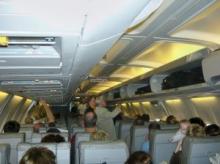You may get this question from patients with respiratory compromise — from kids with cystic fibrosis to adults who have chronic obstructive pulmonary disease.
So what should you tell them? It depends. Ask where they are going, how long the flight(s) is, and about any previous air travel experiences.
Increased cabin pressure and susceptibilty to micro-organisms in re-circulated air are the two main clinical concerns, said Dr. Susan Millard, a pediatric pulmonologist at Helen DeVos Children’s Hospital in Grand Rapids, Michigan.
Ensure your patient passes a walk test. They will likely need this functional capacity to do some limited walking in the airport and to get through security screening (getting through screening is challenging enough, even without any pulmonary issues).
TSA rules for portable oxygen concentrator use are outlined in the agency’s recommendations for travelers with hidden disabilities.
“Cystic fibrosis patients will ask us to develop a letter, which is especially important if they are going through customs,” Dr. Millard said at a pediatric pulmonology seminar sponsored by the American College of Chest Physicians and the American Academy of Pediatrics in Fort Lauderdale, Fla. Include the patient’s contact information, insurance policy numbers, and physician or clinic telephone numbers. Some airlines require physicians complete a form in advance of the patient’s traveling, so advise your patient to check their airline requirements before ticket purchase, she added.
Waiting at least 6 weeks after lung surgery or major intervention is advised in Eurpoean recommendations on traveling with cystic fibrosis released in December 2010. This consensus statement addresses preparations for travel (e.g., vaccinations, packing medication); important considerations during travel; and issues specific to the immunocompromised. Absolute contraindications for travel also are outlined.
Scientists are looking for ways to reduce every traveler’s exposure to airborne pathogens, Dr. Millard said. For example, one study shows commercially-available biosensors are not sensitive enough to detect airborne biological contaminants, at least not in a meaningful way. You would have to be on a flight with at least seven infected passengers either coughing 20 times per hour or sneezing four times an hour to get the bacteria levels up to detectable levels. And no sensor in the study worked well with airborne viruses.
In the meantime, developing better sensors or screening individual passengers for infectious respiratory illness prior to boarding would be the best approaches, she said.
Also, don’t forget to fasten your seatbelt.
–Damian McNamara (@MedReporter on Twitter)



